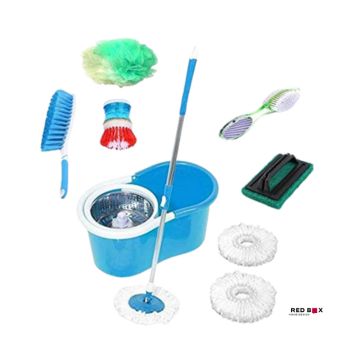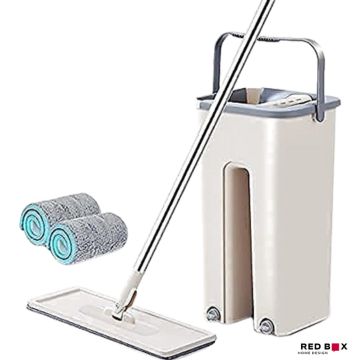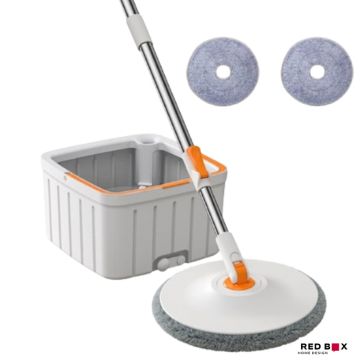I. Introduction
Mop buckets play a vital role in the cleaning process, providing an efficient way to handle dirty water and keep floors sparkling clean. With various types of mop buckets available in the market, choosing the right one can be overwhelming. In this complete guide, we will explore the different types of mop buckets, their features, pros and cons, and factors to consider when making a purchase decision.
Table of Contents

1. Standard Mop Buckets
Standard mop buckets are the tried and true tools for cleaning floors. These buckets typically consist of a sturdy plastic or stainless steel construction. They come in different sizes to oblige different cleaning needs. The most common sizes include small buckets for residential use and larger ones for commercial settings.
The components of a standard mop bucket include a bucket with a handle and a wringer attachment. The wringer is used to squeeze excess water out of the mop, making it easier to achieve the desired level of dampness for effective cleaning. Some mop buckets also feature a removable wringer for easy cleaning and maintenance.
While standard mop buckets are widely used and readily available, they do have their pros and cons. On the positive side, they are affordable, user-friendly, and versatile. However, they may require more physical effort, as the wringing process is manual. Additionally, they may not be the best choice for large-scale cleaning projects as they might not have the capacity to hold a significant amount of water.
JSN Spin Mop Bucket Set

- magic mop microfiber cleaning technology durable superior water absorbency non-abrasive Its reusable washable essential spin.
- mop with bucket 360 degrees rotating mop for easy and better cleaning keeps user hand totally clean no extra power consumption and eco friendly.
- mop spin floor cleaning combo mop bucket offer mopping check out video and images for more details on assembly and usage of the mop
- usage wet and dry floor easy to use store and carry oval bucket with drainage separate cleaning
2. Wringer Mop Buckets
Wringer mop buckets offer a convenient solution for squeezing out excess water effortlessly. Unlike standard mop buckets where the wringing is done manually, wringer mop buckets feature built-in wringer mechanisms that make the task much easier. These mechanisms can be operated through pedals or levers, allowing for a hands-free wringing experience.
There are different types of wringer mechanisms available. The most common ones include side press, down press, and microfiber press. Side press wringers require you to press a lever on the side of the bucket to activate the wringing mechanism. Down press wringers, on the other hand, work by pressing down on a lever that applies pressure to the mop, squeezing out the water. Microfiber press wringers are specifically designed for use with microfiber mops, as they have a gentle squeezing action that helps preserve the delicate fibers.
The advantages of using wringer mop buckets are evident. They minimize physical strain by eliminating the need for manual wringing, making them a great option for individuals with limited strength or mobility. They also provide better control over the dampness of the mop, ensuring optimal cleaning results. However, wringer mop buckets tend to be more expensive compared to standard ones, and their complex mechanisms may require occasional maintenance.
Chakaachak Shine Spin Bucket Mop with Stainless Steel Wringer Plus 1 Free Refill

- Efficient Cleaning: The Chakaachak Shine Spin Bucket Mop Is Designed To Provide Efficient And Hassle-Free Home Cleaning. It’s Perfect For Tackling Dirt, Dust, And Spills On Various Surfaces, Ensuring Your Home Stays Spotless
- Spin Technology: With Innovative Spin Technology, This Mop Allows You To Effortlessly Wring Out Excess Water, Leaving The Mop Damp Enough For Effective Cleaning Without Making A Mess
- Stainless Steel Wringer: The Mop’s Stainless-Steel Wringer Is Not Only Durable But Also Ensures Smooth Wringing, Making It Easy To Control The Level Of Moisture In The Mop For Optimal Cleaning Performance
- High-Quality Material: Crafted From Durable And High-Quality Materials, The Chakaachak Shine Spin Bucket Mop Is Built To Withstand Regular Use, Ensuring It Lasts For A Longer Time.
3. Flat Mop Buckets
Flat mopping has gained popularity in recent years due to its superior cleaning efficiency and time-saving capabilities. Flat mop buckets are specifically designed to accommodate the unique needs of flat mopping systems. These buckets are typically rectangular in shape, featuring a long and shallow design that allows easy submersion of flat mop heads.
The design and features of flat mop buckets contribute to their effectiveness in cleaning. They often come with a press wringer system that allows for precise control over moisture levels. Some buckets also incorporate color-coding systems to prevent cross-contamination when using different cleaning solutions. The size of flat mop buckets varies, but they are generally larger than standard mop buckets to hold sufficient water for larger cleaning areas.
Flat mop buckets offer several benefits over traditional mop buckets. They provide better maneuverability in tight spaces and are more efficient in removing dirt and grime. Additionally, the larger capacity of flat mop buckets reduces the need for frequent refilling. However, they may not be as suitable for cleaning in narrow or cluttered areas, as the mop heads require a wider range of movement.
LYSOL Heavy Quality Large Size Floor Mop with Bucket Flat Squeeze Mop Bucket System

- Lysol The mop bucket has 2 separate chambers for washing and drying the mops easily. No handwashing anymore! Squeeze mop Floor cleaning can be much easier with this self-wringing mop and bucket set.
- Suitable for vinyl floors, Christmas Gift Pack wooden floor, bamboo floor, glass floor, stone floor, ceramic tiles floor. Also suitable for cars, room windows and doors cleaning. Note: if use for laminate floors and other surface which easily reserve water, please squeeze water more times before mopping on the floor. Any product problem, please contact us, we will give you satisfied answers.
- Squeeze mop The handle can be extended to 126cm and the flexible 360-Degree swivel head allows for any tight spots and all other hard to reach places.
- The mop bucket is lightweight and doesn’t take up much space, can be easily stored in the corner of your house. Squeeze mop The mop bucket has a portable handle, which is convenient for you to move the cleaning position at will. You are welcome to choose an efficient cleaning mop bucket set.
4. Microfiber Mop Buckets
Microfiber has revolutionized the cleaning industry with its exceptional cleaning capabilities. Microfiber mop buckets are specifically designed to enhance the effectiveness of microfiber mops, providing the ideal environment for removing dirt and bacteria from surfaces. These buckets feature a unique construction that prevents cross-contamination and ensures maximum cleaning efficiency.
Microfiber mop buckets are typically made from durable plastic materials, often with color-coded sections to separate clean and dirty water. The buckets may also come with filtration systems to remove debris and contaminants from the water, keeping it clean for longer. The size of microfiber mop buckets varies depending on the intended use, ranging from compact options for residential cleaning to larger ones for commercial applications.
The advantages of using microfiber mop buckets are numerous. Microfiber is highly effective in trapping dirt and bacteria, making it an excellent choice for homes and healthcare facilities. The filtration systems in microfiber mop buckets help maintain the cleanliness of the water, reducing the risk of spreading contaminants. However, it’s important to note that not all cleaning agents are suitable for use with microfiber mops, as some may damage the delicate fibers. Always check the manufacturer’s recommendations for compatible cleaning agents.
Gala e-Quick Spin Mop, Easy Wheels & Big Bucket with 2 Microfiber Refills, Floor Cleaning Mop

- Easy wheels and puller handle spin mop for floor cleaning, pocha: easy mop comes with easy wheels and puller to easily carry the bucket around the house.
- Microfiber power performance for floor cleaning with magic mop: Microfiber material with its unique feature of deep cleaning helps lift and trap fine dust / dirt particles.
- Hands free wringer: the easy mop bucket comes with wringer that allows you to easily press excess water out of the wet mop, without using your hands.
- Ergonomically designed mop with bucket for hands free home cleaning: this smart / modern equipment keeps your hands away from dirty/ phenyl water. Keeps your hands dry and germs free.
5. Specialty Mop Buckets
In addition to the standard, wringer, flat, and microfiber mop buckets, there are also specialty mop buckets available to cater to specific cleaning requirements. These mop buckets are designed with unique features and applications to meet the demands of specialized cleaning tasks.
One example of a specialty mop bucket is the spin mop bucket. Spin mop buckets feature a centrifugal spinning mechanism that quickly removes excess water from the mop head. This makes them ideal for fast and efficient drying, especially in high-traffic areas that require frequent mopping.
Another example is the dual-chamber mop bucket. Dual-chamber mop buckets have separate compartments for clean and dirty water, allowing for proper separation and preventing cross-contamination. This is particularly useful in healthcare facilities or environments that require strict hygiene practices.
The unique features of specialty mop buckets provide practical solutions for specific cleaning challenges. However, it’s important to assess the specific needs of your cleaning tasks before investing in these specialized options, as they may not be necessary for general cleaning purposes.
FASHIONHARBOUR Wet and Dry mop with Bucket for Floor Cleaning 360° Rotating

- Clean and waste water separation floor cleaning system with a dirty water separation system, you can clearly see the dirty water and clean water after separation. You can always clean the mop with clean water without changing the water frequently.
- Comfortable to use : removable and easily adjustable stainless steel handle, flexible for different body sizes. Easy to carry and easy to store, save space. There is a drain hole at the bottom of the mop bucket. After cleaning the floor, simply open the lid to drain the wastewater.
- Microfibre spin mop head flat mop with 2 microfibre mop pads, wet and dry, machine washable and super absorbent. It can easily absorb dirt, dust, hair and other particles on the floor surface to achieve a streak-free cleaning effect that can perfectly clean all types of floors such as wood, hardwood, marble, tiles, vinyl, laminate.
- Water Saving And Labor Saving Spin mop and bucket system only half a gallon of water is needed for each cleaning,rinse clean spin mop & bucket, It can save most of the water. During our mopping process, because there is only a small amount of water on the mop, the ground will quickly return to normal.
II. Factors to Consider When Choosing a Different Types of Mop Buckets
Selecting the right mop bucket for your cleaning needs is crucial to ensure efficiency and effectiveness. Here are some key factors to consider before making a purchase decision.
1. Size and Capacity
The size and capacity of a mop bucket should be chosen based on the size of the cleaning area. For residential cleaning, a smaller-sized bucket may be sufficient. However, for larger commercial spaces, a larger bucket with a higher water capacity may be necessary to minimize the need for frequent refilling.
It’s also important to consider storage space constraints when choosing the size of a mop bucket. Ensure that the selected bucket can be easily stored without taking up excessive room.
2. Material and Durability
Mop buckets are commonly constructed using plastic or stainless steel materials. Plastic cans are lightweight, reasonable, and impervious to rust. On the other hand, stainless steel buckets are more durable, long-lasting, and easy to clean. Consider the specific needs of your cleaning tasks and the desired longevity of the mop bucket when choosing between these materials.
The choice of material can also affect the performance and maintenance of mop buckets. Plastic buckets may be prone to cracking or deterioration over time, while stainless steel buckets can withstand heavy use and harsh cleaning agents.
3. Additional Features and Accessories
Mop buckets now come with a variety of optional features and accessories to enhance convenience and functionality. These can include wheels for easy maneuverability, built-in soap dispensers for easy soap application, and splash guards to prevent water from splashing out during the wringing process.
When considering these extra features, it’s important to assess their usefulness and practicality for your specific cleaning tasks. Some features may add unnecessary complexity or increase the cost of the mop bucket, while others may significantly improve efficiency and convenience.
III. Proper Maintenance and Care for Mop Buckets
Proper maintenance and care are essential for prolonging the lifespan of mop buckets and ensuring hygienic cleaning. Here are some best practices to follow:
1. Cleaning and Disinfecting
After each use, thoroughly clean the mop bucket to remove dirt, grime, and any cleaning agents. Start by emptying the dirty water and rinsing the bucket. Then, use a suitable cleaning agent and scrub the interior surfaces to remove any residue. Rinse the bucket thoroughly and allow it to air dry.
To prevent bacterial growth, it’s important to regularly disinfect the mop bucket. Use a disinfectant solution recommended by the manufacturer and follow the instructions for proper application. Pay special attention to the wringer mechanism and any crevices that may harbor bacteria.
2. Storage and Organization
To maintain cleanliness and prevent odors, it’s important to store mop buckets properly. After cleaning and disinfecting, ensure that the bucket is completely dry before storing it. Moisture can lead to the growth of mold and mildew, which can be detrimental to the bucket’s lifespan and cleanliness.
Consider using proper drying techniques, such as allowing the bucket to air dry in a well-ventilated area or using a fan to speed up the drying process. Avoid storing mop buckets in damp or humid areas, as this can promote the growth of mold and mildew.
For those who need to store multiple mop buckets, organization solutions can be beneficial. Consider using racks or shelving systems designed specifically for mop bucket storage. This helps keep the buckets neatly organized and easily accessible when needed.
3. Inspection and Replacement
Regular inspection of mop buckets is essential to identify any signs of damage or wear. Check for cracks, leaks, or breakdowns in the wringer mechanism. If any part of the mop bucket is damaged, it may compromise its functionality and effectiveness.
Certain signs indicate the need for mop bucket replacement. Excessive wear and tear, excessive rusting in stainless steel buckets, or irreversible damage that affects the bucket’s performance are indicators that it’s time for a new one.
When selecting a replacement mop bucket, consider the factors discussed earlier, such as size, material, and additional features. Ensure that the new bucket meets your specific cleaning needs and requirements.
Pros
- Efficient Cleaning: Mop buckets are designed to efficiently clean and sanitize floors. They allow for the easy application and wringing of mop heads, ensuring thorough cleaning without excessive effort.
- Versatility: Mop buckets come in various sizes and designs, catering to different cleaning needs. Whether you’re cleaning a small residential space or a large commercial area, there’s a mop bucket suitable for the task.
- Cost-Effective: Mop buckets are generally affordable and offer a cost-effective solution for maintaining cleanliness. They provide a reusable and durable cleaning tool, reducing the need for frequent replacements.
- Hygiene Maintenance: Many mop buckets come equipped with features such as wringer mechanisms and splash guards, helping to maintain a hygienic cleaning process. These features prevent cross-contamination and ensure that dirty water is effectively separated from the clean solution.
- Ease of Use: Mop buckets are user-friendly and require minimal training. They are accessible to both professionals and homeowners, making them a practical choice for a wide range of users.
Cons
- Manual Labor Intensive: Despite their efficiency, mop buckets rely on manual effort for wringing out the mop and refilling the bucket. This can be physically demanding, especially for larger cleaning tasks.
- Limited Mobility: Mop buckets are typically stationary, which can be a drawback when cleaning in large or irregularly shaped spaces. This limitation may require users to frequently move the bucket to cover a larger area.
- Risk of Spills: Accidental spills can occur during the filling, emptying, or transportation of mop buckets. This poses a risk of creating slippery surfaces, potentially leading to accidents and injuries.
IV. Summary
In this complete guide, we covered the different types of mop buckets, including standard, wringer, flat, microfiber, and specialty mop buckets. Each type has its own remarkable highlights, benefits, and detriments. When choosing a mop bucket, it’s important to consider factors such as size and capacity, material and durability, and additional features and accessories.
Proper maintenance and care are essential for prolonging the lifespan of mop buckets. Regular cleaning, disinfecting, and proper storage techniques ensure hygienic cleaning and prevent the growth of bacteria and mold.
By understanding the different types of mop buckets available and considering the factors discussed, you can make an informed decision and choose the mop bucket that best suits your cleaning needs.
V. Frequently Asked Questions (FAQs)
- What is the ideal mop bucket size for residential cleaning?
- The ideal mop bucket size for residential cleaning depends on the size of the cleaning area. For small to medium-sized residential spaces, a smaller-sized bucket, such as a 5-gallon bucket, is typically sufficient. However, larger homes may require a slightly larger bucket, such as a 7-gallon one.
- Can I use any cleaning agent with a microfiber mop bucket?
- Not all cleaning agents are suitable for use with microfiber mops. Harsh chemicals or bleach-based cleaners can damage the delicate fibers of the microfiber mop. It’s best to refer to the manufacturer’s recommendations for compatible cleaning agents.
- How often should I replace my mop bucket?
- Mop bucket replacement frequency depends on several factors, including the material and quality of the bucket, the frequency of use, and the level of maintenance. Signs of excessive wear and tear, irreparable damage, or compromised functionality indicate the need for a replacement.
- Are specialty mop buckets worth the investment?
- Whether specialty mop buckets are worth the investment depends on your specific cleaning requirements. Specialty mop buckets offer unique features and applications that can significantly enhance cleaning efficiency and convenience for certain tasks. Assess your needs and consider the benefits before making a decision.
- Can I use a wringer mop bucket for flat mopping?
- While it is technically possible to use a wringer mop bucket for flat mopping, it may not be the most efficient option. Flat mopping systems are specifically designed to accommodate the unique needs of flat mop heads, while wringer mop buckets are designed for different types of mops. It’s generally recommended to use a flat mop bucket for optimal performance in flat mopping tasks.
